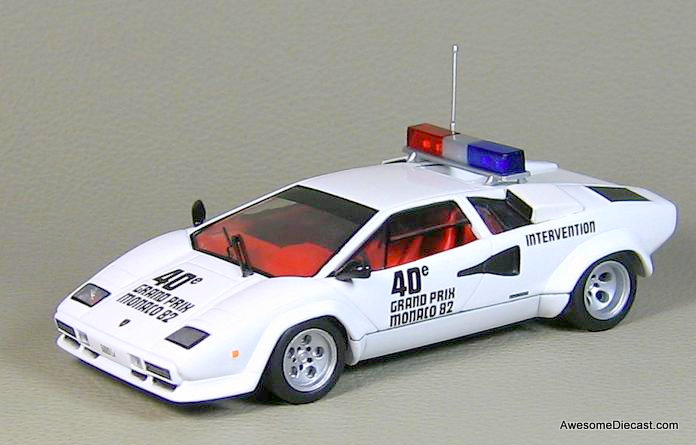IXO Models
IXO 1:43 Ferrari 308 GTB, 1982 Rally Monte Carlo
This model comes mounted on a base and displayed in an acrylic case, it is a replica of the car driven by J.C. Andruet

The Lamborghini Countach is a rear mid-engine, rear-wheel-drive sports car produced by the Italian automobile manufacturer Lamborghini from 1974 to 1990. It is one of the many exotic designs developed by Italian design house Bertone, which pioneered and popularized the sharply angled "Italian Wedge" shape.
A second generation limited edition Countach, the Lamborghini Countach LPI 800-4 was launched in 2021.
The style was introduced to the public in 1970 as the Lancia Stratos Zero concept car. The first showing of the Countach prototype was at the 1971 Geneva Motor Show, as the Lamborghini LP500 concept
The development of the Countach was initiated by Ferruccio Lamborghini with the goal of creating a successor to the Miura. The Miura was widely acclaimed after its introduction in 1966, but by 1970 new competitors including the Ferrari Daytona had been introduced to the market, and the Miura was showing its age. Chief engineer Paolo Stanzani and his staff began work on the Miura successor in 1970 under the project name "LP112." From the beginning of the project, Stanzani's collaborators included test driver Bob Wallace, assistant engineer Massimo Parenti and designer Marcello Gandini of Bertone.
The Countach name originated in late 1970 or 1971, near the beginning of the LP112 project. Most previous and subsequent Lamborghini car names are associated with famous bulls and bullfighting, but the Countach broke with this tradition. The name originated from the word contacc, an exclamation of astonishment in the Piedmontese language.
In motorsport, a safety car, or a pace car, is an automobile which limits the speed of competing cars or motorcycles on a racetrack in the case of a caution period such as an obstruction on the track or bad weather. The aim of the safety car is to enable the clearance of any obstruction under safer conditions, especially for marshals and/or await more favourable track conditions weather-wise.
During a caution period the safety car (which generally consists of an aptly modified high-performance production car) enters the track ahead of the leader. Depending on the regulations in effect, competitors are not normally allowed to pass the safety car or other competitors during a caution period, and the safety car leads the field at a pre-determined safe speed, which may vary by series and circuit. At the end of the caution period, the safety car leaves the track and the competitors resume normal racing. The first reliance on this safety measure occurred with the deployment of a pace car during the inaugural Indianapolis 500 in 1911
The Monaco Grand Prix (French: Grand Prix de Monaco) is a Formula One motor racing event held annually on the Circuit de Monaco, in late May or early June. Run since 1929, it is widely considered to be one of the most important and prestigious automobile races in the world, and is one of the races—along with the Indianapolis 500 and the 24 Hours of Le Mans—that form the Triple Crown of Motorsport. The circuit has been called "an exceptional location of glamour and prestige".
The race is held on a narrow course laid out in the streets of Monaco, with many elevation changes and tight corners as well as a tunnel, making it one of the most demanding tracks in Formula One. In spite of the relatively low average speeds, the Monaco circuit is a dangerous place to race due to how narrow the track is and the race often involves the intervention of a safety car. It is the only Grand Prix that does not adhere to the FIA's mandated 305-kilometre (190-mile) minimum race distance for F1 races.
The Monaco Grand Prix was part of the pre-Second World War European Championship and was included in the first World Championship of Drivers in 1950. It was twice designated the European Grand Prix, in 1955 and 1963, when this title was an honorary designation given each year to one Grand Prix race in Europe. Graham Hill was known as "Mr. Monaco" due to his five Monaco wins in the 1960s. Ayrton Senna won the race more times than any other driver, with six victories, winning five races consecutively between 1989 and 1993.